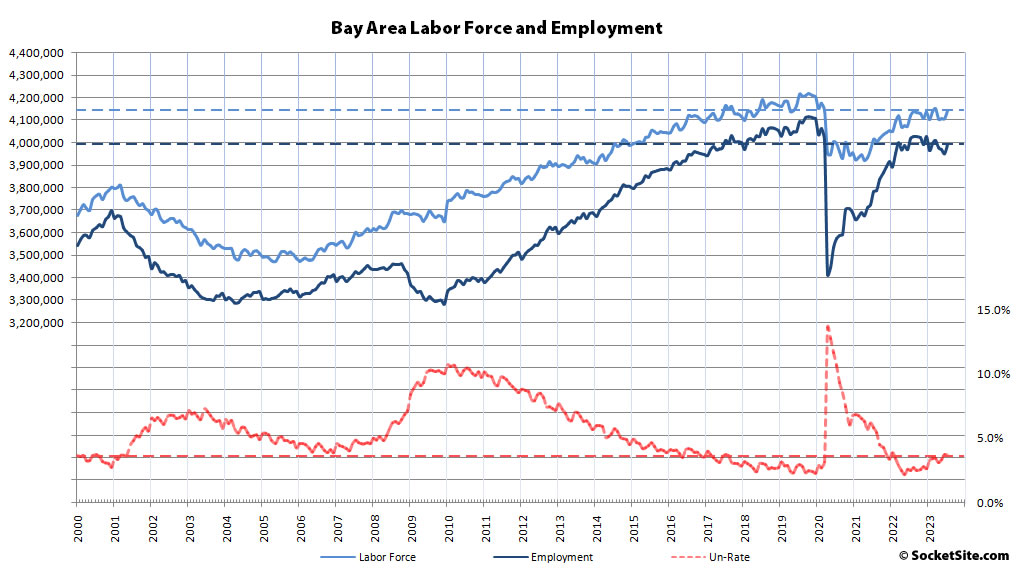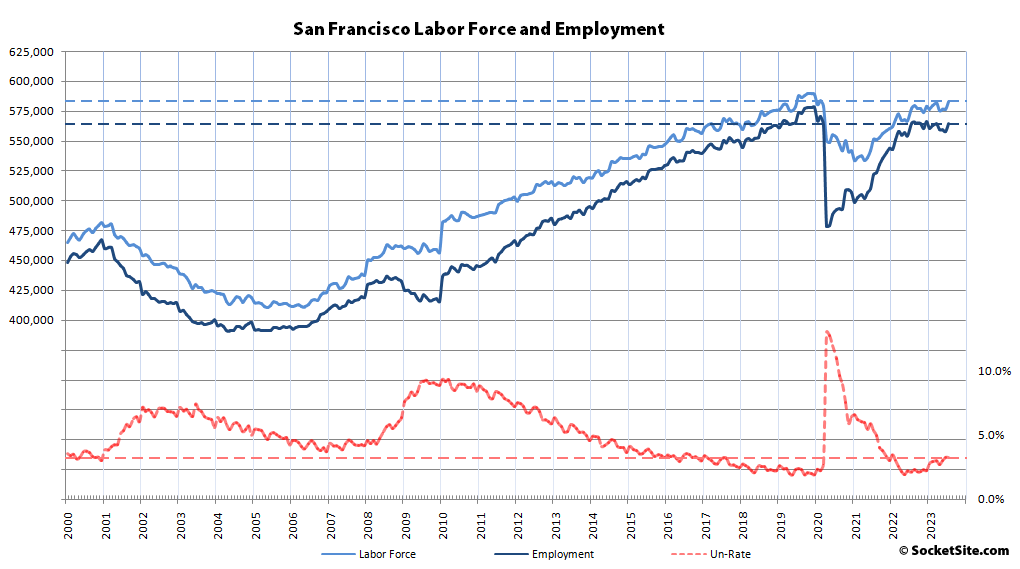Having dropped in June, the number of San Francisco residents with a job increased by 6,300 in July to 564,200, a seasonally driven increase that could mislead some.
In fact, employment in San Francisco actually slipped on a year-over-year basis last month, representing the first year-over-year decline in employment since the pandemic ended and the post-pandemic recovery began, with 13,900 fewer employed people in San Francisco at the end of last month than there were at the end of 2019, prior to the pandemic, 6,200 fewer people in the local labor force (583,100), and an unemployment rate of 3.2 percent.
At the same time, while the number of employed East Bay residents increased by 12,900 from June to July with typical seasonality in play, employment slipped by 11,400 on a year-over-year basis to 1,522,500, representing the largest year-over-year drop since the pandemic ended, with 51,000 fewer employed residents than prior to the pandemic, nearly 28,000 fewer people in the labor force (1,589,200) and an unemployment rate of 4.2 percent.
While the number of employed residents spread across San Mateo and Santa Clara Counties increased by 16,300 in July to 1,464,000, employment was down by 14,300 on a year-over-year basis, with 28,500 fewer employed people in Silicon Valley than there were prior to the pandemic, 8,500 fewer people in the local labor force (1,515,200) and an unemployment rate of 3.4 percent.
Net employment across Marin, Napa and Sonoma counties increased by 4,000 in July to 439,800 and was actually up by 500 on a year-over-year basis but with nearly 22,000 fewer employed residents than there were prior to the pandemic and over 16,000 fewer people in the combined labor force (455,900) for an unemployment rate of 3.5 percent.
As such, while the net number of Bay Area residents with a job increased by 39,500 from June (3,951,000) to July (3,990,500) with typical seasonality in play, total employment actually dropped by 25,700 on a year-over-year basis, representing the third straight month with a year-over-year decline and the largest such decline since the pandemic ended, with 115,000 fewer employed residents than there were prior to the pandemic and nearly 59,000 fewer people in the labor but an unemployment rate of “only 3.7 percent,” none of which should catch any plugged-in readers by surprise.


So seriously ed., are you just pessimistic by nature? Are you trying to drive the market? Last month it was “Bay Area Employment Drops, Trending Down” … then when there’s actually an *increase* this month, the headline still hunts for the negative. This is a consistent feature of this blog – even good news is couched with negativity – “Bay Area Home Values Tick Up; Still Down 11% YOY”.
I get this isn’t the best R.E. market, and I’m definitely with you on exposing some misleading broker tactics (such as in the flyer I received a couple days ago, touting a “17 days on market, over asking” sale of a house near Edna Maguire in Mill Valley, when I personally walked by that house with a “For Sale” sign in front of it for multiple months, and it sold for less than it’s *initial* listing amount. But there’s a difference between shining a light of clarity or truth, and spinning everything negatively – such as here, where it seems to me there’s a fairly steady employment line over the last ~18 months, which is changing on a statistically meaningless level of +/- 0.02% or 0.01% per month. It’s kind of getting old.
It’s not a matter of being “pessimistic” or “negative,” despite the weak barbs or misreationalizaitons, it’s a matter of actually understanding the data and key drivers of the market. And Yes, Bay Area Employment Is Actually on the Decline.
From The Mercury News, Tech companies reveal plans to jettison hundreds more Bay Area jobs, earlier today:
One of the middle paragraphs says that “while painful and wrenching for employees, the latest disclosures fit into a pattern of a steady slowdown in the pace of layoffs for tech companies in the Bay Area.” It would be informative to see a breakdown of how many people being laid off are citizens or permanent residents vs. people here on H1-B or other similar work visas. I have never seen that stat in any news story about this topic.
Nor are you likely to, unless that info is part of the EDD filings; I don’t believe it is, altho there might be a concurrent filing with the INS (if anyone wants to put in the effort to find out I’ll cover their Socketsite subscription for a year….Hell, it’s a lot of work, let’s make it two years!!)
🙂